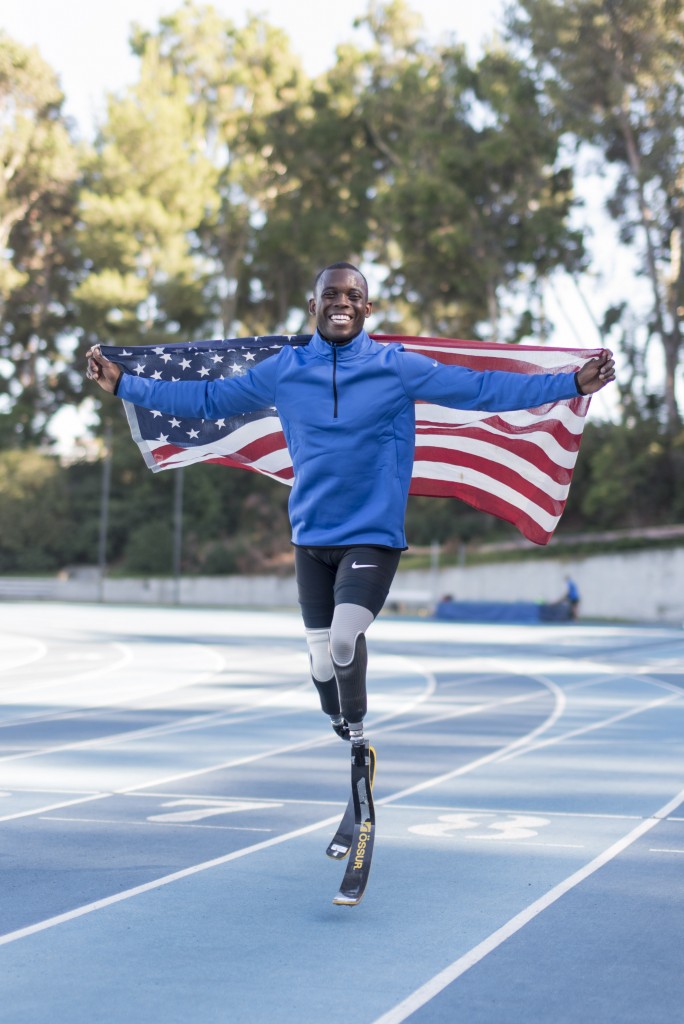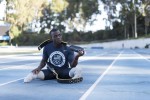If you walk into Drake Stadium on a weekday around 11 a.m., you’ll see a group of elite-level athletes working out with legendary sprint coach and UCLA alum John Smith.
Allyson Felix, a four-time Olympic gold medalist, could be there one day. Tyson Gay, a sprinter for the U.S. Olympic Team, could be there another. Fellow Olympic sprinters Gil Roberts and English Gardner are there as well.
Running alongside Roberts in the 400-meter is another world-class athlete. But this athlete was born without calves, ankles or feet. His name is Blake Leeper.
Leeper is one of the top Paralympians in the world, winner of a silver and bronze medal in the 400-meter and 200-meter, respectively, in the 2012 Paralympic Games in London. The sprinter has been training at UCLA since January under the tutelage of former Olympian and NFL wide receiver Willie Gault – a member of the John Smith coaching tree.
But the path Leeper took to training with Smith’s sprinting club is a long and windy one – and it wasn’t planned out. Originally, he was working out at the U.S. Olympic Committee training center in Chula Vista, California, alongside another prestigious coach with UCLA ties – Al Joyner.
Then, things were thrown off course when Leeper tested positive for cocaine in a June 2015 test with the U.S. Anti-Doping Agency.
Though the USADA deemed that Leeper wasn’t using cocaine for performance-enhancing purposes, it still banned him from competition for one year. The ban also prevented the Paralympian from using any USOC training centers.
“That was rock bottom for me,” Leeper told WJHL-TV in Tennessee.
The violation marked a crossroads in both Leeper’s life and athletic career. The 26-year-old could either allow the suspension to effectively end his chances for the 2016 Paralympic Games, or he could come clean and continue to train for his next opportunity at trials in June 2016.

Leeper decided to take the latter route.
He partnered with a new management team, aiming to get his life back on track and away from the off-field distractions.
“My new management team came into my life and tried to rearrange everything,” Leeper said. “They had some great connections.”
Led by local entrepreneur Bob Lorsch and his wife Kira, a UCLA alumna, the team enrolled Leeper in drug rehabilitation programs and looked for alternative locations where he could train while he served his ban. Lorsch introduced Leeper to his new coaches, Smith and Gault, as well.
At first, Leeper said he needed to prove himself to these two coaches. Neither Smith nor Gault had ever worked with a Paralympian before.
“They’re at first kind of skeptical,” Leeper said. “This is a situation that they have to see with their own eyes, and I understand that.”
Leeper’s first tryout for Gault came on January 1, 2016, at Drake Stadium. Gault asked him to run a sequence of repeat 200s, requesting that each be completed in 27 to 28 seconds at the most.
Leeper outperformed Gault’s expectations, running the repeat 200s in 25 to 26 seconds.
“Once I saw him workout, I knew he had the ability,” Gault said. “It’s just a matter of experience, and getting experience with the guys he’s running with.”
Over the next several weeks, Leeper continued to practice with Gault at UCLA. But he still had this sense that the coaches were taking it easy on him, treating him differently than the other non-amputee sprinters.
“At first, they’re (like), ‘How do we treat Blake? Do we give him sympathy? Do we take it easy on him?,’” Leeper said.
The sprinter allowed his work ethic to talk for him. While some of the other athletes took days off to rest, Leeper kept coming back to train every day.
One morning, Smith surprised Leeper. He made mention of the Paralympian’s work ethic in a group meeting with all of his Olympic sprinters. He was talking to the group about the importance of gratitude, being thankful for your talents and he pointed out Leeper as the prime example.
“You look at Blake, and you look at his attitude. He comes out here and gets it,” Smith told the group. “Take the time to applaud him and thank him for coming out here and giving all he’s got.”
That’s when Leeper realized he had arrived, that he had proven himself among this elite group of athletes, amputee or not.
“That moment … it solidified that I’m one of them – that I’m part of the group,” Leeper said. “And that made my week, made my month.”
A few months later, Leeper’s ban was lifted, and he was able to compete in the U.S. Paralympic Trials on June 30 to July 2, 2016 in Charlotte, North Carolina.
There, Leeper saw his hard work pay off, winning gold in the 200-meter and the 400-meter, and silver in the 100-meter. He will compete in each of those three events in the 2016 Paralympics in Rio de Janeiro, this September.
“I put in my blood, sweat and tears at Drake Stadium every single day to better myself,” Leeper said. “I consider myself an honorary Bruin (alum), because I trained here. Everybody at UCLA accepts me for me.”
What inspires him to come back to the UCLA track every day isn’t the material goal of winning a gold medal in Rio. Sure, Leeper said he wants the gold and some world records at the 2016 Paralympics, but he’s aiming to make a larger impact when he runs.
“There’s a little kid out there that has a disability, physical or mental – whatever the situation or challenge that they’re going through – I hope they can see my story and say, ‘You know what, Blake’s a fighter,’” Leeper said. “That’s why I go out there and do what I do.
“That’s the greatest feeling in the world – knowing that you changed somebody’s mindset and inspired somebody.”
